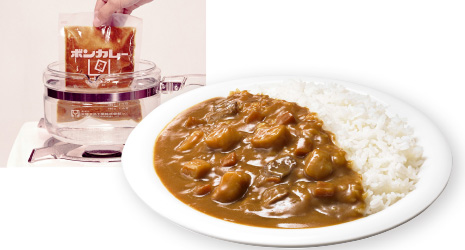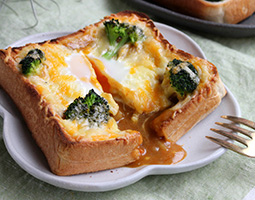INDEX
- English
- 日本語

Retort pouch food from 1968 heated by submersing the pouch in hot water (left); Retort pouch curry with rice (right) - English
- 日本語

The retort pots first used to sterilize food products

A creative way of using retort pouch curry
June 2020
Ready-to-Eat Food for All Occasions

What we now call “retort pouches for food” were first investigated by American researchers for use as US military field rations in the 1960s. However, it was a Japanese company that developed the technologies which led the way to the popularization of ready-to-eat foods in retort pouches and their entry into markets around the world.
Colorful packages of ready-to-eat food line the shelves of Japanese supermarkets and convenience stores. The varieties continue to increase year after year, with more than 100 companies now selling over 500 varieties of retort-pouch packaged foods.
Retort-pouch foods are foods that have been sealed in pouches or other containers made from plastic film, metal or multiple layers of these materials, and then have been sterilized at a high temperature and pressure in a pot called a retort. Whether it be by submersing the pouch in boiling water for three minutes or placing the contents in the microwave for two minutes, these foods can be heated up easily and in no time. Consequently, steamed white rice, curry, stew, hamburger steaks, and other packaged foods are familiar in everyday life in Japan.

A vacuum-sealed package of sausage to be used as a field ration by the US Army was introduced in a professional packaging journal in the United States in 1964. Taking a hint from that, Otsuka Foods Co., Ltd. developed “Bon Curry,” the world’s first commercially available curry in a pouch in 1968. According to Kamiya Hitomi of the product division at Otsuka Foods, development of the product utilized technology belonging to the Otsuka Group, which was founded as a pharmaceutical company.
“Curry was a very popular national dish in Japan even at that time. Product developers thought it would be convenient to be able to buy a single portion of curry that could be eaten just by heating it up with hot water. They began a process of trial and error to create the conditions in which food could be stored long-term at room temperature, retaining its form and deliciousness without the use of preservatives. To achieve this, they created an original retort that would sterilize food using heat and pressure by utilizing technology for sterilization of IV drips.”
Initially the researchers found that their method caused potatoes and other ingredients in the curry to lose their shape and the spices to lose their aroma, but they continued to refine their cutting techniques and adjusted degrees of pressure and heat, and finally came up with a successful recipe.
In the year after sales began, the three-layer construction of polyethylene, aluminum and polyester was developed for the pouch, giving the curry a two-year shelf life at room temperature. However, the product was met with skepticism at first, with many doubting that a tasty curry could be prepared in “just three minutes” and others wondering if the pouches in fact contained heaps of preservatives. Nevertheless, the curry’s reputation grew over time, reaching 100 million units in total annual sales domestically in 1973.
Later, many companies entered the market for ready-to-eat foods, and other popular dishes besides curry such as hashed beef and pasta sauces became widely available in retort pouches.
First-class hotels and well-known restaurants also began to sell their specialty dishes as high-quality ready-to-eat food in pouches. These high-end brand packaged curries, soups, stews and other foods are never cheap, but they are nevertheless popular, including as seasonal gifts.
Lately, such foods have come to be sold online due to their excellent shelf life, enabling consumers to enjoy specialty foods from around Japan, even while travel has been discouraged to prevent the spread of COVID-19.
Packaged foods are an essential household presence as a source of emergency food, too. And stockpiled ready-to-eat food in pouches is a staple provision for victims at evacuation shelters when major disasters strike.

“Ready-to-eat foods in pouches, which do not contain preservatives and can be stored long-term at room temperature, make for excellent emergency foods during disasters,” says Kamiya. “They contain meat, vegetables and other nutritious ingredients, and they can even be eaten cold if no heat source is available.”
Ready-to-eat foods in pouches have become an integral part of the eating habits of Japanese people, both in normal times and in times of emergencies.

